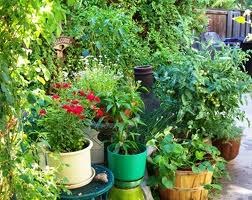Containers are a great way to garden for those with limited space or are short on time. They add landscaping to front doorways, decks, balconies, and patios. Plus they are portable and can be moved to different locations as needed.

Choose from clay, glazed ceramic pots, wooden barrels, plastic pots, or wire baskets. Just about anything that can hold soil and drains well can be used as a container. Make sure the chosen container has enough drainage holes so that water flows freely after watering to keep the roots from becoming water logged. Also, consider the container location and make sure that it complements its surroundings.
PLANT SELECTION/DESIGN BASICSChoose plants that work well with the container and its desired location. Use shade loving plants in shady locations and sun loving plants in sunny locations. (6 or more hours of direct sunlight).
There are a variety of plant shapes and sizes to choose from. A combination of spikey, trailing, upright or round creates an attractive design. Choose plants that are in scale with both container size and container location. Plants that are too large will overwhelm the container but containers with small plants will lack impact. A general rule of thumb is that the tallest plant should be twice as tall as the container.
Make sure plants are healthy and have a strong root system. The roots should fill the pot, but should not be growing out of the bottom of the pot or cell pack.
GROWING MEDIAA well-drained growing medium is essential for container plants. Use potting soil or soilless potting mixes that are readily available in nurseries or home centers. These mediums are designed to provide the drainage and moisture needed by container plants. Do not use native garden soil or prepackaged garden soils. Both native garden soil and prepackaged garden soils are suited to plants grown in a garden environment and do not provide enough drainage and aeration for container grown plants.
PLANTINGNow that the container, plants, and growing media have been chosen, it's time to create the container. Fill the container with soil and place the plants in the desired design. Plants in containers can be more closely spaced than in the garden using twice as many plants as a garden would require. Set plants at the same depth as they were in the cell pack or pot.
WATERINGWater requirements vary considerably depending on the plants and container size. Check daily for water needs and thoroughly soak the soil until water drains from the drainage holes. As the plants mature during the summer, the container will need to be watered more frequently.
FERTILIZINGContainer plants need more fertilizer than plants in a regular garden. Their rapid growth quickly depletes the available nutrients in the container soil. Two types of fertilizers are available, timed release and soluable. Timed release fertilizer which is added to the soil mix at planting time. Time release fertilizers release a small amount of fertilizer each time the container is watered. Soluble fertilizers are added to the irrigation water and can be used full strength or diluted. Follow the product directions for concentrations and timing. Either one or both methods of fertilization can be used in containers.
MAINTENANCERemove spent blooms frequently to encourage plants to continue blooming. Sit back and enjoy!
By Carol Matheson, Master Gardener, 2012 April Newsline
